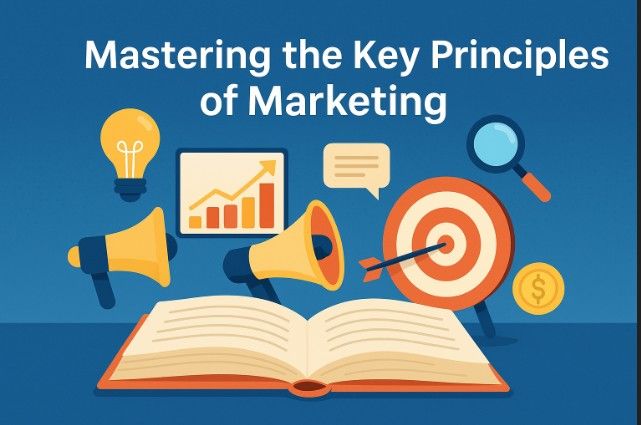
Mastering the Key Principles of Marketing
Brain Tracy identify principles of Marketing, which are as underlisted as follows;
The True Purpose of Business
Most people think the purpose of business is to make a profit. But legendary thinker Peter Drucker had a different take. He said: The real purpose of a business is to create and keep a customer. And Brian Tracy builds on that profits are simply the result of doing that well. Remember: it costs a lot to win a new customer, but keeping one? That’s way cheaper and far more valuable in the long run.
Quality as a Competitive Edge
Which is the most powerful marketing strategy of all time? Quality. Tracy says 90% of your success comes from how good your product or service actually is. Customers will pay more for quality and they’ll come back for it, again and again.
Philip Crosby defined quality simply: It’s when a product does what it promises—and keeps doing it. A brand, in the end, is just promises made and promises kept.
Service & Relationships
It’s not just about what you sell—it’s about how you make people feel. According to the Harvard PIMS study, quality includes the service experience. And as Jan Carlzon of SAS Airlines once said, every single interaction is a moment of truth. Those moments build or break customer loyalty.
Customer Acquisition Costs:
Here’s the cold truth; you have to buy customers. And you must do it at a cost lower than their lifetime value.
If your customer acquisition costs are higher than what you earn from them, your business model is broken. Watch that metric like a hawk Segment.
Four Approaches to Marketing
Brian Tracy outlines four timeless strategies:
💫Utility: Solve a real problem. Think FedEx and overnight delivery.
💫Pricing: Use pricing to make your product more accessible. Like Henry Ford did with the Model T.
💫Customer Reality: Adapt to how people behave. Remember Sears and their money-back guarantee?
💫True Value: Deliver unmatched benefits. IBM made service reliability their edge.
Three Marketing Questions
Before you launch anything, ask: Is there a market for this? Is the market big enough? Can I reach this market effectively? Miss any of those, and you’re heading for the 80% of product launches that fail.
Customer-Focused Marketing
Customer obsession isn’t a buzzword—it’s a business strategy. Tracy highlights examples like IBM, where whoever answers the phone owns the problem. And TruLux restaurants? They win by making service their superpower.
Why People Buy
Here’s the psychology: People buy with emotion, then justify with logic. The ABC model breaks it down:
Antecedents – Past experiences or marketing.
Behaviors – The act of buying.
Consequences – The satisfaction they expect to feel.
They buy to solve problems, hit goals, and feel something—whether it’s status, comfort, or control.
Know Your Competition
You have to understand your competitors better than they understand themselves.
Ask: Why do customers choose them? What can you offer that they can’t? Case in point—Blackberry stuck to the same old playbook while Apple and Samsung ran circles around them.
Competitive Advantage
If you want to win in your space? Don’t just be different—be the best at something your customer truly values.
That’s your Unique Selling Proposition, your USP. And it’s the key to standing out without getting dragged into price wars.
The 7 Ps of Marketing
Let’s break down the classic Marketing Mix:
- Product – What are you selling?
- Price – Is it profitable and competitive?
- Promotion – How are you spreading the word?
- Place – Where do customers find you?
- Packaging – What’s their first impression?
- Positioning – How do they perceive you?
- People – Who’s delivering the experience?
Positioning Strategies
Great brands own a single word. Think: FedEx = “overnight.” Walmart = “low prices.”
Even underdogs can win. Avis embraced their #2 status with “We Try Harder.” Brilliant.
Marketing Meets Military Strategy
Marketing can be war.
Objective: Have a clear mission.
Offensive: Keep innovating.
Mass: Focus your resources.
Maneuver: Stay flexible.
Surprise: Do the unexpected.
Exploit: Scale what works—fast. Think Apple and the first iPhone. Game changer.
Tactical Warfare in Marketing :
Sometimes, subtle moves win the game.
Stay under the radar. Keep innovations secret.Redirect your competitors’ focus to things that don’t matter. It’s all about strategy.
Growth Strategies Here’s how to grow
Sell more to your current customers. Launch new products for them. Enter new markets.
Or partner with others—joint ventures can open doors fast.
Distribution Channels
Your product is only as good as your distribution.
Explore online, retail, franchises—whatever works for your market. Remember how Avon evolved from door-to-door to office sales as women entered the workforce? That’s adapting.
Bundle of Resources
Your business is more than what it sells—it’s a bundle of skills and assets. Intel started with memory chips. Then pivoted to microprocessors. Huge move.
Reinventing Your Business
Want to stay relevant? Do more of what works. Do less of what doesn’t. Start new ideas. Stop what’s outdated.
This is called zero-based thinking. Let go of what no longer serves you.
Conclusion
Marketing is strategy. It’s about perception, value, and relentless focus on the customer. Innovate or die. Test, learn, adapt. And remember what Brian Tracy says: “Your competition determines your success—outthink, outmaneuver, and outperform them.”
References
- Brian tracy. (2024, July 30). Mastering the Key Principles of Marketing . YouTube. Marketing by Brian Tracy Full Audiobook
- Tomiwa Awodun (Valdymas Intelligence). (2025). Summary of “Mastering the Key Principles of Marketing”



